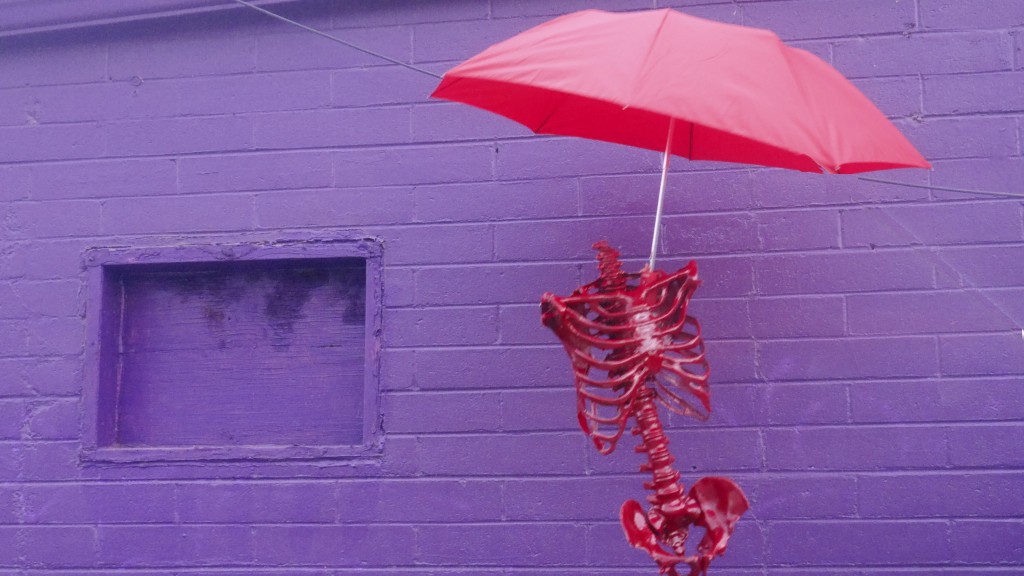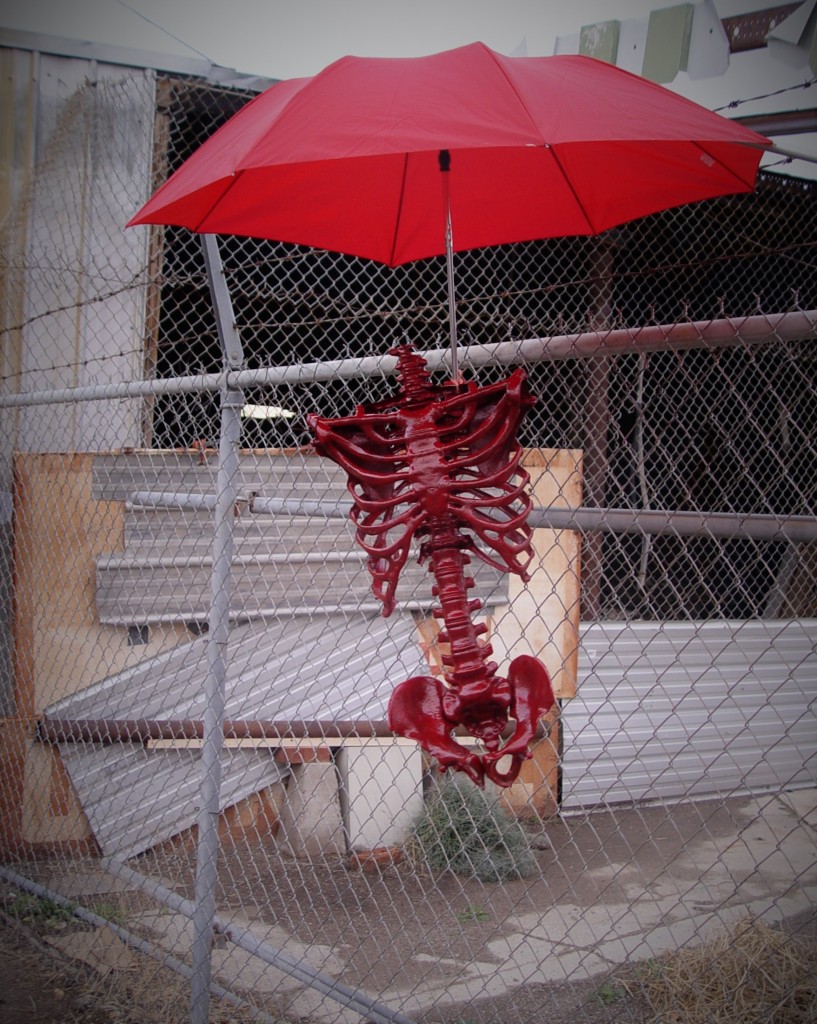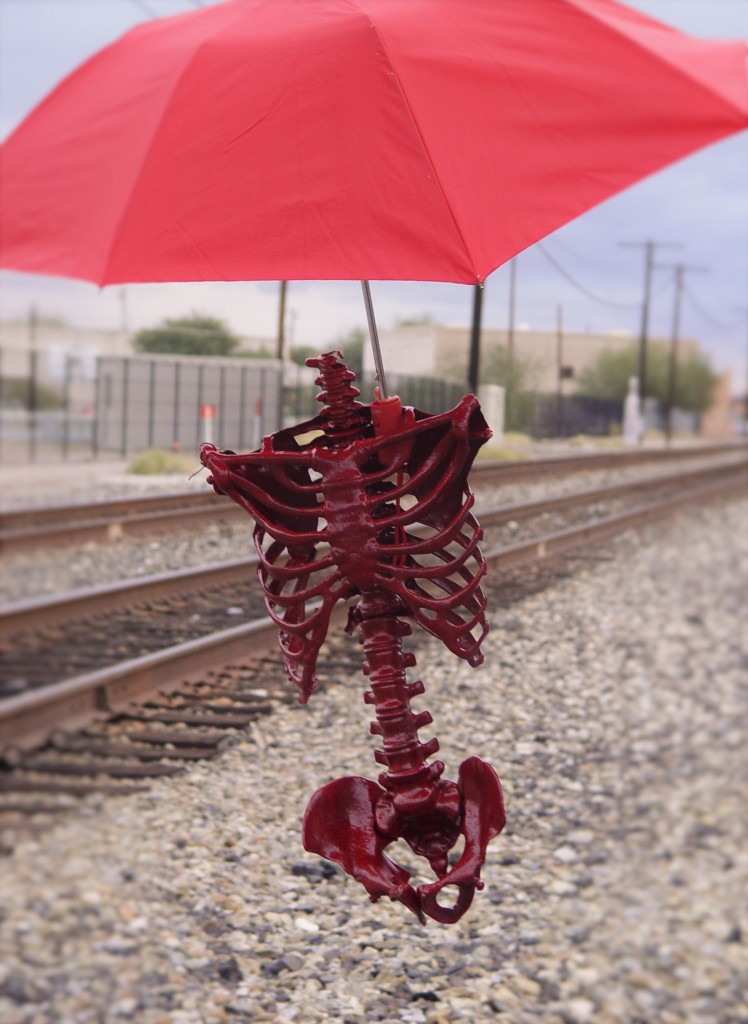Hannah Rose Johnson, Arizona, USA, SSH Blog Correspondent
 “The body of the sex worker is one that does not have personal boundaries. Someone who people penetrate all the time. Just like air penetrating the skeleton’s body,” says Maggie Palmer of Hey Baby! Art Against Sexual Violence! in Tucson, AZ, of her latest art piece.
“The body of the sex worker is one that does not have personal boundaries. Someone who people penetrate all the time. Just like air penetrating the skeleton’s body,” says Maggie Palmer of Hey Baby! Art Against Sexual Violence! in Tucson, AZ, of her latest art piece.
“The skeleton has no skin layer, which centers the mis-perception that sex workers can’t experience street harassment because they are not fully human.” The skeleton sculpture exists in liminal space, she says. “It’s not what we identify as a body, and is clearly a body.” This is symbolic of the ways in which communities deal with gender violence and the deconstruction of heteronormativity and compulsory heterosexuality.
Maggie started the piece for December 17th, the International Sex Workers Day of Remembrance. The purpose of the piece is to use the red umbrella, the chosen symbol of resistance for sex workers, and incorporate themes of invisible bodies through the use of the skeleton. The skeleton has dual meanings–violence against sex workers and intersectional identities such as immigrant, drug users, trans bodies, and people of color. She says, “It centers that violence against sex workers is violence against other marginalized identities. By invisibilizing violence against sex workers, violence is invisibilized against these other identities.”
 The cultural narrative built around sex workers is that their bodies are disposable and live in the margins. It is purposeful that Maggie hangs the skeleton in public spaces rather than enclosed buildings. Sex worker bodies are pushed to the margins and bringing the sculpture into the street recenters those margins. She says, “The skeleton’s boundaries are permeable. There is an idea that the dominant power structure is surveilling marginalized bodies…and that the marginalized body is fundamentally flawed. Flaw creates circumstance, as opposed to looking at institutionalized racism, transphobia etc. If you are not fully formed, you have created this. And if you conform to society’s expectations, you don’t have to live a marginalized experience.”
The cultural narrative built around sex workers is that their bodies are disposable and live in the margins. It is purposeful that Maggie hangs the skeleton in public spaces rather than enclosed buildings. Sex worker bodies are pushed to the margins and bringing the sculpture into the street recenters those margins. She says, “The skeleton’s boundaries are permeable. There is an idea that the dominant power structure is surveilling marginalized bodies…and that the marginalized body is fundamentally flawed. Flaw creates circumstance, as opposed to looking at institutionalized racism, transphobia etc. If you are not fully formed, you have created this. And if you conform to society’s expectations, you don’t have to live a marginalized experience.”
What I find so interesting is that thinking about circumstance invokes the value of choice. But choice is not a factor when we look and name systems and institutions that are built on racism, neoliberal economics and heteronormativity. Maggie and I agree that neither lived experience of survival sex and sex work as a choice is more or less valid. “The sex worker body loses the right to consent,” she says. When a body loses the right to consent, that body has no boundaries. If a body doesn’t have boundaries, acts of violence are justified. Social systems, the way we treat “normal” bodies versus “perserve” bodies reflect gender violence that is bound up in racism, neoliberal economics, citizenship status, HIV status, gender identity and sexual orientation. This is uncomfortable, which Maggie demonstrates in her sculpture.
“The way the sculpture moves in space is disorientating. It swings back and forth, it is a hanging piece. It blows around and does unexpected things you can’t control. This symbolizes how disorienting it is for communities to deconstruct heteronormativity,patriarchy, and gender violence. It forces us to get into a space of ‘unknown.’”
 Maggie says that street harassment, a form of sexual violence, is a way in which to subjugate and turn bodies into commodities for aesthetic pleasure. And street harassment sometimes punishes for not being aesthetically pleasing enough. This sculpture breaks that gaze, and shocks it. The viewer is reminded of what gender violence and sexual violence really is. She tells me that the skeleton is very exposed, and so is street harassment and sexual violence. Maggie says, “The skeleton is calling upon who has the right to privacy. Marginalized do not have access or the right to privacy.” The viewer can see right through the skeleton, can see the landscape and city scape right through the ribs and behind the torso.
Maggie says that street harassment, a form of sexual violence, is a way in which to subjugate and turn bodies into commodities for aesthetic pleasure. And street harassment sometimes punishes for not being aesthetically pleasing enough. This sculpture breaks that gaze, and shocks it. The viewer is reminded of what gender violence and sexual violence really is. She tells me that the skeleton is very exposed, and so is street harassment and sexual violence. Maggie says, “The skeleton is calling upon who has the right to privacy. Marginalized do not have access or the right to privacy.” The viewer can see right through the skeleton, can see the landscape and city scape right through the ribs and behind the torso.
She says, “This piece is representative of the continuum of violence and social constructs that make violence against sex workers possible.”
The sculpture is currently back in a bag in a closet somewhere in southern Arizona.
Hannah Rose is writing from Tucson, Arizona and Lewiston, Maine (US) as she transitions from the Southwest to the Northeast for a career in sexual violence prevention and advocacy at the college level. You can check her out on the collaborative artistic poetic sound project HotBox Utopia.
